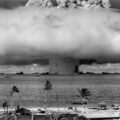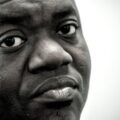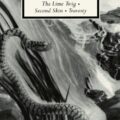The Light of Possibilities: On Patrick Park’s Tucumcari

From the opening sentence of Patrick Parks’ remarkable debut novel Tucumcari, readers are invited into the bewildered reality of a man whose life exists in an interwoven fabric of the grounded world and his untethered imagination. In the world of this novel, as is increasingly true of our own world, facts represent just one version of events among a wealth of other possibilities, all of which, in their own way, are true.
A man wakes one morning and remembers he has a wife, whose name is Audrey, and she is perhaps a potter, or a rancher, or the owner of a small café. They met and married during a drunken night in Las Vegas, but she lives in Tucumcari. This man, the narrator, decides he will take Boyd Delmarco, a former radio personality dying from a lung disease, with him to Tucumcari, where there is a clinic known for its miracles. As he prepares for this trip, he shares with the reader the varying versions of the life that brought him to this moment.
He relates the story of his father, a soldier who worked on the first atomic bomb and spent the rest of his life running from the fear that bomb released. Everything the family owned was always ready to be packed into their station wagon for the next journey to the next place radiation was least likely to fall. His mother wrote short stories, which the man admits he is now rewriting and including as parts of this novel; her stories are of a round-faced boy who loves his radio and listens each night to a man who reads the Word of God out into the night. They also feature the atomic soldier who pulls his wagon through the endless ash. These stories were his mother’s way of making sense of the world.
The form of the novel is poetic. Repetition, patterns, language, images, and metaphor create both momentum and meaning. Early in the story, the narrator tells us he has a phototropic condition which causes him to be weighted to the ground by light during the day and to float at night. “Photosynthesis was invented 3.9 billion years ago,” he explains later, “by a prokaryotic cell called Promethio. Promethio was the first living being capable of taking energy from the sun and thriving on it. Promethio, of course, was named after Prometheus, who stole fire from the gods and suffered for it.” Multiple vignettes in the novel reference the intensity of the light that came from the first atomic bomb. “I think about my father at this time of the day, sunset, when the falling ash turns red,” the narrator explains. “The clouds of ash turn red too and the whole world outside my window seems to have caught fire. I think about my father then because I think that this might have been what the whole world looked like to him when the bomb went off.”
Images and facts and stories of light permeate the novel, creating both shape and resonance in place of a more traditional narrative plot or character arc. This structure is essential to the novel’s thematic exploration of the human need to use imagination as a means of surviving our lives. When faced with the inexplicable, we create stories that, to us, in that moment, seem true. Given time and repetition, some become Truth.
The opening epigraph from Albert Einstein claims products of the imagination are the equals of reality. Part of the charm and mystery of this novel is the absolute veracity with which Parks spins all events and information, both factual and imagined. In the chapter “A Match Made in Heaven,” the man relates multiple versions of how his parents met and married: they were childhood sweethearts in the hills of Nebraska; they met after the war when he was selling textbooks and she was a teacher; they were introduced by a friend at a dance; they met at the motel owned by her parents. All seem to be equal possibilities.
In “True Stories about Tucumcari,” the narrator shares two versions of how the town got its name, the legend of Tuscaloosa Tom, information about Playa Largo where the Ute Indians discovered flight and an ancient tree hangs from a rock, the cut-lip sturgeon, and that John Muir, Ken Kesey, Patti Page, Ruby Woodridge, Gene Tunney, and Stan Getz were all born in Tucumcari. Ranches drill for water but more often end up with oil. A wooly mammoth skeleton was found in 1929, but it was taken to a larger city for display.
These versions and alternate versions are full of both whimsy and heartbreak. Parks has a deep empathy for the ways humans shatter and regather their lives, the struggle to make sense of a world steeped in the inexplicable. The narrator and his parents are coping, as humans have always done, by telling themselves stories that imply order and meaning in a seemingly random reality. Science, religion, mythology, a voice reaching out from the radio—the narrator latches on to whatever gets him through his floating nights.
Through his characters, Parks is able to explore the malleability of memory and intention. Perhaps the narrator is the childhood friend of Boyd Delmarco; perhaps he lost his shoes—and one sock—in the mud of Delmarco’s grandmother’s garden; or perhaps he lay in bed as a small boy, listened to Delmarco’s radio show, and began inserting himself into Delmarco’s remembered life. Is the narrator’s intention to save Delmarco’s life by taking him to Tucumcari the act of an old friend or a delusional fan? All we know for certain is the narrator’s whole-hearted desire to save Delmarco’s life, but the relationship between them lies somewhere between the poles of best friends during childhood and stalker/stalkee.
The ways in which this novel mirrors contemporary culture are unsettling. The standard, dependable narratives that used to be found in newspapers and evening broadcasts have been supplanted by images and jingoistic bursts of language designed to fragment and disrupt the relationship between fact and truth. Facts are no longer definitive. Truth is wholly subjective. We are what we believe.
This timely novel is to be treasured for the rich prose and witty intellect that inform the boldness of its storytelling. Parks is willing to risk the safety of a more traditional approach in order to press readers into a different kind of knowing, a truth that is more deeply felt than thought. He embraces the timeless human necessity to make stories from what we think we know and transform them into what we know we believe.
Top: Blue Swallow Motel, Route 66, Tucumcari, NM; photo by Jerry Huddleston
About Rachael Stewart
Rachael Stewart is a Professor of English at Elgin Community College, and the Director of the Writers Center of ECC, an outreach program that hosts events for creative writers and a reading series featuring six authors per year. She holds an MFA from the Bennington Writing Seminars.





